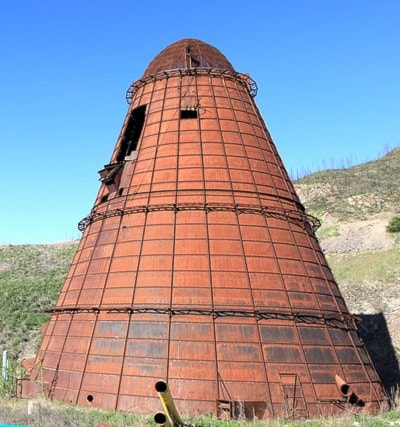By Megan English
The saw mill at Louis Creek began in the early 1940’s, and over the years there were a total of three bee hive burners used on the site. Each one was replaced for something more efficient and less polluting. In the mid 1970’s the third bee hive was built. My great-grandpa, Mienhart Witte, was the lead construction millwright on the project, and it was his job to design the layout of the burner.
This bee hive burner had a base of 70 feet and a height of 70 feet. In the late 1980’s it had to be “re-skinned”. This meant they had to put all new plates around the outside of the burner. This was important to help control the amount of oxygen that got inside the burner, so they could control the temperature inside. There was a brick control room that held the temperature gauges, and this is where mill workers would watch and control how warm or how cold it was inside the burner. When the burner got too hot, the dampers opened to cool it down. The control room was run electronically, so it would automatically adjust the dampers as needed. One of the workers, usually the fireman, would check on it a couple times during his shift. The burner rarely needed to be cleaned out, because it burned up to 1100 degrees, making it so there was very little, to no waste left.
During the 2003 McLure Wildfire, the Tolko Mill at Louis Creek burned down, but the burner survived. The bee hive burner was made to withstand extreme temperatures up to 1100 degrees, making it the only mill structure that was left standing. The loss of the mill caused our community to change. Tolko had been the largest employer, providing 180 jobs, as well as impacting other businesses.
Many families moved away to find new work. The families that stayed behind worked together to make sure that each other’s needs were met. The Salvation Army set up a warehouse and hired my dad to work with many volunteers to hand out clothes and household items to those that lost their homes and jobs due to the wildfire. I was three-years-old and got to help hand out toys and fold clothes.
In 2011 the Louis Creek bee hive burner was finally torn down and removed from the mill site. Many in the community were sad to see it go. They felt it was part of our community history, and should be left standing so that we would remember the tragedy of the fire and how it impacted us and our community.
The bee hive burner at Louis Creek was the most modern in the province, only to be topped by the one in Vavenby. It was known as one of the largest burners in the province of B.C., and possibly all of Canada.
In 1995, the Government of B.C. brought in a regulation that required all bee hive burners near communities to be shut down by December 31, 1997. A study showed that bee hive burners could be the cause of deaths, hospital stays, emergency room visits, loss of work and school days to people with breathing problems such as asthma and bronchitis.
Since then, the mills have replaced the burners with steam plants which create electricity or hog fuel. So now the waste gets put into these plants, as it breaks down, they use the steam to create energy which can then be used to power the mill.
Many of the bee hive burners that remained have since been torn down, but Malakwa, B.C., found an interesting way to keep their’s in use. They turned their burner into a restaurant called The Burner.
Over the years, the Louis Creek Tolko Mill gave many tours of the mill site to people from around the world. Often, they came for the purpose of seeing the bee hive burner. People came from the Netherlands, Japan, and a number of other countries. Some overseas guests on the tours criticized the burner, saying the energy created by the burner was being wasted, and could be used to run the mill, making it more energy efficient. At the time, these visitors said they thought this showed Canada was less advanced in preventing air pollution.
* Megan English wrote this article as part of her grade 7, 2012 Barriere Elementary School Heritage Fair project.
